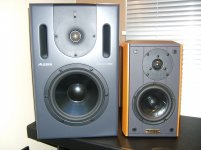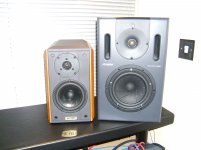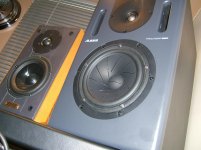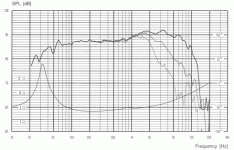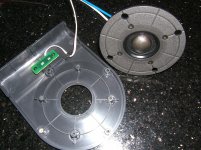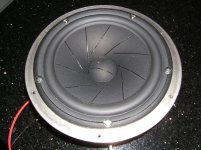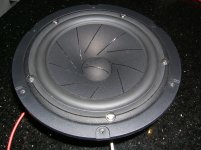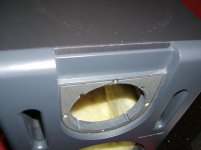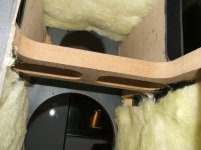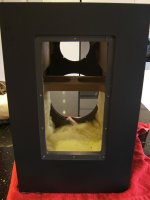Hi. Anybody able to help or point me in the right direction..? I have my own project recording studio and have decided to upgrade my Alesis ProLinear 820 monitors as they are not detailed or revealing enough in the upper midrange frequencies. The bass extension is very good, but compared to my reference speakers (Ruark Solus and Dynaudio Finale) the Alesis 820s sound as though they have a void in the upper midrange frequencies. These monitors are used for playing instruments through prior to mix down and need to be accurate. Compression may not be fully effective during this period, so the use of my reference speakers is out of the question just in case any sound peaks pass through to the transducers and ruin them. The Alesis monitors are an active bi-amped configuration.
I have been unhappy with the sound for a while now from these monitors. They originally cost approx £800, so in order to replace them with something better would be a costly exercise. With this in mind I have embarked on changing the drivers to improve the sound and this is where the problem lies.
The standard transducers in the Alesis ProLinear 820’s are unknown. However, comparing these with units advertised on the Madisound website, they may be Hi-Vi or Silver Flute produced items. The woofer is an 8” Kevlar woven unit and the tweeter is a 1” soft dome type. I just happen to have some spare drivers available to use in an upgrade trial. These consisted of Scan-Speak Revelator 18W/8531-G00 woofer and the Scan-Speak Classic 2905-97000 tweeter. The 8531 is a smaller driver than that originally supplied with the Alesis 820s. So a 2,0mm thick titanium adapter ring was made to fit the Scan-Speak driver in the cabinet.
After this change the unit was tested and compared to the unmodified cabinet. The result was so much better. The detail and clarity of the Scan-Speak driver was immediate. The bass extension was slightly less but the lower frequencies were tighter. This on the whole was a vast improvement over the original driver and I was delighted with the results.
I then decided to take the next step and replace the tweeter. The original tweeter sits behind a plastic wave guide and uses a dampening material between the faceplate and the waveguide. Fortunately, the Scan-Speak tweeter uses the same PCD as the Alesis tweeter, so it was a simple matter of swapping over the faceplates to enable the fitment of the Scan-Speak tweeter. Once this was installed and the cabinet tested, again an immediate improvement in the overall clarity was perceived. However, this was somewhat thwarted by what sounded like break-up and distortion in the lower high frequency range. I then placed a digital graphic equaliser between the mixing desk output and the Alesis monitors to try and identify the frequency range this problem occurred and narrowed it down to frequencies between 1650 and 2000 Hz, where the more prominent harshness occurred. This was a crude method of analysis but the only one that I had. This problem does not occur after re-fitment of the original Alesis tweeter. So it is associated with the tweeter / crossover.
As identified above the improvement in sound accuracy is vast and more suited to my ear using the Scan-Speak drivers. I find that the Alesis are too muddy and lack clarity and accuracy. I am wondering whether the next step is to improve the crossovers to suit these drivers. There is no crossover information available from Alesis for the 820 ProLinear model or nothing on the drivers for that matter. The cabinets are reasonably solid and internally braced. They are front ported using two slots placed either side of the tweeter. The port tubes are of paper construction.
Any help in identifying why the SS tweeters should distort around 1650 – 2000 Hz would be appreciated and any assistance on improving the crossover in the Alesis amp would also be greatly welcomed.
I have included a couple of photos illustrating the units with the different drivers installed, although the SS and Alesis tweeter units are hidden. More photos of the amps / cabinet construction can be posted on request. Many thanks… D
I have been unhappy with the sound for a while now from these monitors. They originally cost approx £800, so in order to replace them with something better would be a costly exercise. With this in mind I have embarked on changing the drivers to improve the sound and this is where the problem lies.
The standard transducers in the Alesis ProLinear 820’s are unknown. However, comparing these with units advertised on the Madisound website, they may be Hi-Vi or Silver Flute produced items. The woofer is an 8” Kevlar woven unit and the tweeter is a 1” soft dome type. I just happen to have some spare drivers available to use in an upgrade trial. These consisted of Scan-Speak Revelator 18W/8531-G00 woofer and the Scan-Speak Classic 2905-97000 tweeter. The 8531 is a smaller driver than that originally supplied with the Alesis 820s. So a 2,0mm thick titanium adapter ring was made to fit the Scan-Speak driver in the cabinet.
After this change the unit was tested and compared to the unmodified cabinet. The result was so much better. The detail and clarity of the Scan-Speak driver was immediate. The bass extension was slightly less but the lower frequencies were tighter. This on the whole was a vast improvement over the original driver and I was delighted with the results.
I then decided to take the next step and replace the tweeter. The original tweeter sits behind a plastic wave guide and uses a dampening material between the faceplate and the waveguide. Fortunately, the Scan-Speak tweeter uses the same PCD as the Alesis tweeter, so it was a simple matter of swapping over the faceplates to enable the fitment of the Scan-Speak tweeter. Once this was installed and the cabinet tested, again an immediate improvement in the overall clarity was perceived. However, this was somewhat thwarted by what sounded like break-up and distortion in the lower high frequency range. I then placed a digital graphic equaliser between the mixing desk output and the Alesis monitors to try and identify the frequency range this problem occurred and narrowed it down to frequencies between 1650 and 2000 Hz, where the more prominent harshness occurred. This was a crude method of analysis but the only one that I had. This problem does not occur after re-fitment of the original Alesis tweeter. So it is associated with the tweeter / crossover.
As identified above the improvement in sound accuracy is vast and more suited to my ear using the Scan-Speak drivers. I find that the Alesis are too muddy and lack clarity and accuracy. I am wondering whether the next step is to improve the crossovers to suit these drivers. There is no crossover information available from Alesis for the 820 ProLinear model or nothing on the drivers for that matter. The cabinets are reasonably solid and internally braced. They are front ported using two slots placed either side of the tweeter. The port tubes are of paper construction.
Any help in identifying why the SS tweeters should distort around 1650 – 2000 Hz would be appreciated and any assistance on improving the crossover in the Alesis amp would also be greatly welcomed.
I have included a couple of photos illustrating the units with the different drivers installed, although the SS and Alesis tweeter units are hidden. More photos of the amps / cabinet construction can be posted on request. Many thanks… D
Attachments
I'm not sure but
1. maybe the original tweeter was a 3Ohm driver Alesis 1" Shielded Soft Dome Tweeter 279-140
2. maybe the xover was a 3 order, with output predominance on/after the xover region
3. difficult to know (for me) without running full simulations, with drivers and crossovers.
4. anything can happen.
5. and 6. Unless you know what you're doing (the woofer was fine as you said) (or you can build your own) change for a new monitor (ADAM A7X £895, A8X £1,195, EVENT Elect. (Alesis-Russell Palmer) 20/20BAS £758, MACKIE, M-AUDIO Studiophile BX8A Deluxe)
1. maybe the original tweeter was a 3Ohm driver Alesis 1" Shielded Soft Dome Tweeter 279-140
2. maybe the xover was a 3 order, with output predominance on/after the xover region
3. difficult to know (for me) without running full simulations, with drivers and crossovers.
4. anything can happen.
5. and 6. Unless you know what you're doing (the woofer was fine as you said) (or you can build your own) change for a new monitor (ADAM A7X £895, A8X £1,195, EVENT Elect. (Alesis-Russell Palmer) 20/20BAS £758, MACKIE, M-AUDIO Studiophile BX8A Deluxe)
Have you tried removing the tweeter from the cabinet and plastic wave guide, leaving it connected to the active electronics of the speaker? After this play back something that highlights the problem and see if its still there. If it is then you can rule out any mechanical vibration from mounting.
An SS 9700 should handle what your throwing at it assuming there's no odd EQ in the active electronics of the Alesis. So it could be a defective driver. Do you have a pair of 9700 and if so are they both exhibiting this behaviour?
One other thing to try is connecting the tweeter up to an amp(not the alesis) with a cap inline and then listen for the problem. If its gone then its likely the problem is caused by the active electronics.
An SS 9700 should handle what your throwing at it assuming there's no odd EQ in the active electronics of the Alesis. So it could be a defective driver. Do you have a pair of 9700 and if so are they both exhibiting this behaviour?
One other thing to try is connecting the tweeter up to an amp(not the alesis) with a cap inline and then listen for the problem. If its gone then its likely the problem is caused by the active electronics.
To help Damski, he might not know that actives (speakers) where worked out with DSPs/PREAMPs and have corrections for the defective drivers they are using. So, I think most of the times or when you know they are present (the corrections) you can not trow another different driver. In a passive you change the crossover of the speaker for a new driver, sometimes is not possible. In an active you change the electronics (Amp/PRE).
Wondering what the "frequencies between 1650 and 2000 Hz" are about... probably I will never know.
I would say (because is in the woofer range) it's from the woofer and not from the tweeter. I can not see that xover/amp having a big influence on the tweeter sound, besides them being different (different impedance to start with?), just because xover point must be higher. But as I said I will never know.
Wondering what the "frequencies between 1650 and 2000 Hz" are about... probably I will never know.
I would say (because is in the woofer range) it's from the woofer and not from the tweeter. I can not see that xover/amp having a big influence on the tweeter sound, besides them being different (different impedance to start with?), just because xover point must be higher. But as I said I will never know.
Attachments
Last edited:
Thanks for the responses chaps.
In answer to your questions…
ShinOBIWAN – Both tweeters exhibit the distortion in the frequency range stated when boosted using the EQ (with all other frequencies reduced). I have taken your advice and removed the wave guide from the faceplate of the tweeter to reduce any potential for mechanical vibration and again the distortion is still evident.
Inductor – I was at first a little puzzled about the frequency range for the tweeter distortion / break-up at around 1650 Hz and thought this should be woofer territory. However, I can confirm that it is the tweeter and not the woofer. I removed the woofer from the unit and left the tweeter connected and vice-versa to prove where the distortion lies.
After a little research into the Alesis ProLinear 820 I have found that the crossover point is 1500 Hz, which surprised me as I thought it may be higher; in the region of 2.5 – 3.0 kHz. However, the Fs for the Scan-Speak 2905-970000 tweeter is 500 Hz, so I wouldn’t have expected any distortion / break-up at 1650 Hz. Would any of you concur with this statement..? Therefore, I suspect that both of you may well be correct with the setup of the amp and active circuitry in the monitor contributing to the distortion in this range. Are there any modifications that can be easily tried and tested to improve the amp/crossover..?
I have included some more photos of the drivers, cabinet construction and amplifier.
The original Alesis drivers are: Tweeter 7-02-0031, Woofer 7-02-0035 just for completeness.
Thanks… D
In answer to your questions…
ShinOBIWAN – Both tweeters exhibit the distortion in the frequency range stated when boosted using the EQ (with all other frequencies reduced). I have taken your advice and removed the wave guide from the faceplate of the tweeter to reduce any potential for mechanical vibration and again the distortion is still evident.
Inductor – I was at first a little puzzled about the frequency range for the tweeter distortion / break-up at around 1650 Hz and thought this should be woofer territory. However, I can confirm that it is the tweeter and not the woofer. I removed the woofer from the unit and left the tweeter connected and vice-versa to prove where the distortion lies.
After a little research into the Alesis ProLinear 820 I have found that the crossover point is 1500 Hz, which surprised me as I thought it may be higher; in the region of 2.5 – 3.0 kHz. However, the Fs for the Scan-Speak 2905-970000 tweeter is 500 Hz, so I wouldn’t have expected any distortion / break-up at 1650 Hz. Would any of you concur with this statement..? Therefore, I suspect that both of you may well be correct with the setup of the amp and active circuitry in the monitor contributing to the distortion in this range. Are there any modifications that can be easily tried and tested to improve the amp/crossover..?
I have included some more photos of the drivers, cabinet construction and amplifier.
The original Alesis drivers are: Tweeter 7-02-0031, Woofer 7-02-0035 just for completeness.
Thanks… D
Attachments
And here are a series of photos illustrating the amplifier section…
Attachments
-
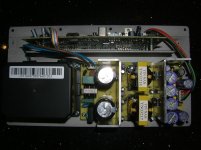 DSCF3782.jpg561.8 KB · Views: 96
DSCF3782.jpg561.8 KB · Views: 96 -
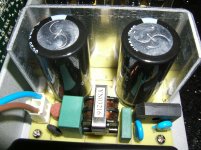 DSCF3785.jpg700.4 KB · Views: 84
DSCF3785.jpg700.4 KB · Views: 84 -
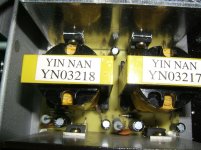 DSCF3786.jpg612.1 KB · Views: 87
DSCF3786.jpg612.1 KB · Views: 87 -
 DSCF3783.jpg705.8 KB · Views: 85
DSCF3783.jpg705.8 KB · Views: 85 -
 DSCF3791.jpg645.8 KB · Views: 92
DSCF3791.jpg645.8 KB · Views: 92 -
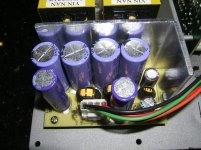 DSCF3784.jpg727.1 KB · Views: 92
DSCF3784.jpg727.1 KB · Views: 92 -
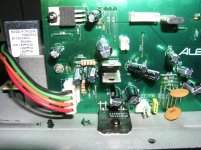 DSCF3788.jpg885.8 KB · Views: 82
DSCF3788.jpg885.8 KB · Views: 82 -
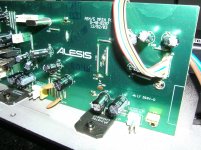 DSCF3789.jpg736 KB · Views: 278
DSCF3789.jpg736 KB · Views: 278 -
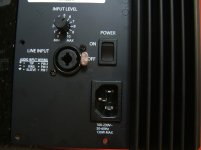 DSCF3801.jpg366.1 KB · Views: 91
DSCF3801.jpg366.1 KB · Views: 91
Again, it seems to me like a lift off of the output frequency (correction) for a 3 order type crossover, at the crossover range, with/for the original tweeter. There is another forum (about valves and solid state) where you can ask that type of question. Look at the bottom.
Information - steph_tsf is playing with "Schematics and simulation using LTspiceIV" here:
http://www.diyaudio.com/forums/multi-way/198663-need-advice-designing-budget-active-speaker.html
Try sending him a PM.
Another experience that we generally do with passives is testing with a variable L-Pad to find/test for some improvements or attenuation (you can use resistors later on).
http://www.diyaudio.com/forums/solid-state/
http://www.diyaudio.com/forums/analog-line-level/
How do you know?An SS 9700 should handle what your throwing at it assuming there's no odd EQ in the active electronics of the Alesis.
Information - steph_tsf is playing with "Schematics and simulation using LTspiceIV" here:
http://www.diyaudio.com/forums/multi-way/198663-need-advice-designing-budget-active-speaker.html
Try sending him a PM.
Another experience that we generally do with passives is testing with a variable L-Pad to find/test for some improvements or attenuation (you can use resistors later on).
http://www.diyaudio.com/forums/solid-state/
http://www.diyaudio.com/forums/analog-line-level/
Last edited:
Again, it seems to me like a lift off of the output frequency (correction) for a 3 order type crossover, at the crossover range, with/for the original tweeter. There is another forum (about valves and solid state) where you can ask that type of question.
Hi Inductor. Would you expect the SS tweeter to break-up below 2 kHz given that the crossover point is 1.5 kHz..? I'll check out the other forum for further information on what you have suggested. Thanks... D
- Status
- Not open for further replies.
- Home
- Loudspeakers
- Multi-Way
- Alesis ProLinear 820 Monitor Upgrade
